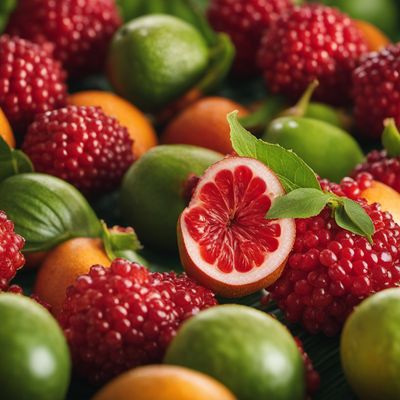
Ingredient
Carambolas and similar-
The Starry Delights of Tropical Fruits
Carambolas are small to medium-sized fruits with a distinctive star shape when sliced. They have a crisp and juicy texture, similar to a combination of apples and grapes, and a flavor that is tangy and slightly sweet. Their appearance is eye-catching, with a bright yellow color and a star pattern when cut.
Origins and history
Carambolas have their origins in Southeast Asia, particularly in Indonesia and Malaysia. They have been cultivated for centuries and are now grown in tropical regions around the world. In many cultures, carambolas are considered a symbol of good luck and are often used in festive celebrations.
Nutritional information
Carambolas are a good source of vitamin C and dietary fiber. They are also low in calories and contain antioxidants that promote overall health. However, individuals with kidney problems should consume carambolas in moderation due to their oxalic acid content.
Allergens
Individuals with kidney problems should consume carambolas in moderation due to their oxalic acid content.
How to select
When selecting carambolas, look for fruits that are firm and free from blemishes or bruises. The skin should be bright yellow and smooth, without any signs of wrinkling or discoloration. Avoid carambolas that are overly ripe or have a dull appearance.
Storage recommendations
To maintain freshness, store carambolas at room temperature until ripe, then transfer them to the refrigerator. They can be stored for up to a week. Avoid washing the fruits until ready to use, as excess moisture can cause them to spoil more quickly.
How to produce
Carambola trees can be grown in tropical or subtropical climates with well-drained soil and plenty of sunlight. They can be propagated through seeds or cuttings and require regular watering and fertilization to thrive.
Preparation tips
Carambolas can be enjoyed fresh, sliced and added to fruit salads, or used as a garnish for cocktails and desserts. They can also be juiced or blended into smoothies for a refreshing tropical flavor. In savory dishes, carambolas can be used in salads, stir-fries, or as a topping for grilled meats or seafood.
Culinary uses
Carambolas are commonly used in Southeast Asian cuisines, particularly in Indonesia, Malaysia, and Thailand. They are also popular in tropical regions such as the Caribbean, Brazil, and India, where they are incorporated into various dishes and beverages.
Availability
Carambolas are primarily cultivated in tropical regions, including Southeast Asia, the Caribbean, South America, and parts of Africa. They are also grown in some subtropical areas, such as Florida and Hawaii.
More ingredients from this category » Browse all

Indian jujubes
The Sweet and Tangy Jewel

Bilimbis
Tropical Tang: Exploring the Unique Flavor of Bilimbis

Natal plums
The Exotic Gems: Natal Plums

Cashew apples
The Tropical Delight of Cashew Apples

Dracontomelon duperreanum fruits
The Exotic Delight: Dracontomelon Fruits

Pommarosas
The Vibrant Pommarosas: A Burst of Tropical Flavor

Santols
The Tropical Delight: Exploring the Exotic Santols

Ambarellas
The Tropical Delight

Purple mombins
The Vibrant Delight: Exploring the World of Purple Mombins

Malay pommarosas
The Exotic Delight: Malay Pommarosas - A Tropical Twist for Your Taste Buds

Maprangs
The Exotic Tanginess of Maprangs

Aonlas
The Tangy Delight: Exploring the Unique Flavors of Aonlas